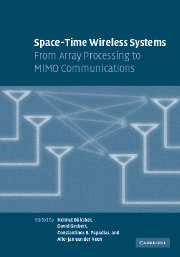Book contents
- Frontmatter
- Contents
- List of contributors
- Acknowledgments
- Introduction
- Part I Multiantenna basics
- Part II Space-time modulation and coding
- Part III Receiver algorithms and parameter estimation
- 12 Array signal processing
- 13 Optimal subspace techniques for DOA estimation
- 14 Blind and semiblind MIMO channel estimation
- 15 MIMO receive algorithms
- 16 Space-time turbo coding
- 17 Training for MIMO communications
- Part IV System-level issues of multiantenna systems
- Part V Implementations, measurements, prototypes, and standards
- Index
13 - Optimal subspace techniques for DOA estimation
Published online by Cambridge University Press: 25 February 2010
- Frontmatter
- Contents
- List of contributors
- Acknowledgments
- Introduction
- Part I Multiantenna basics
- Part II Space-time modulation and coding
- Part III Receiver algorithms and parameter estimation
- 12 Array signal processing
- 13 Optimal subspace techniques for DOA estimation
- 14 Blind and semiblind MIMO channel estimation
- 15 MIMO receive algorithms
- 16 Space-time turbo coding
- 17 Training for MIMO communications
- Part IV System-level issues of multiantenna systems
- Part V Implementations, measurements, prototypes, and standards
- Index
Summary
Signal parameter estimation, and specifically direction of arrival (DOA) estimation for sensor array data is encountered in a number of applications ranging from electronic surveillance to wireless communications. Subspace-based methods have shown to provide computationally as well as statistically efficient algorithms for DOA estimation. Estimator performance is ultimately limited by model disturbances like measurement noise and model errors. Herein, we review a recently proposed framework that allows the derivation of optimal subspace methods, taking both finite sample effects (noise) and model errors into account. We show how this generic estimator reduces to well-known techniques for cases when one disturbance completely dominates the other.
Introduction
Subspace-based techniques have been shown to be powerful tools in many signal processing applications where the observed data consist of low-rank signals in noise. Some examples include sensor array signal processing, harmonic retrieval, factor analysis, timing estimation, frequency offset estimation, image processing, system identification, and blind channel identification. By appropriate use of the underlying low-rank data model and the associated signal and noise characteristics, subspace estimation techniques can often be made computationally and/or statistically efficient.
This chapter focuses on subspace techniques for direction of arrival (DOA) estimation from data collected by a sensor array. This is quite a mature field of research by now; many tutorial papers and books have been presented, some detailing specific aspects and others giving broader views (e.g., Krim and Viberg (1996), Van Trees (2002), and the references therein). We have no ambition whatsoever to give a comprehensive account of the development of the field of DOA estimation in this chapter.
- Type
- Chapter
- Information
- Space-Time Wireless SystemsFrom Array Processing to MIMO Communications, pp. 261 - 278Publisher: Cambridge University PressPrint publication year: 2006



